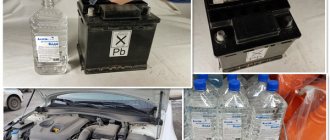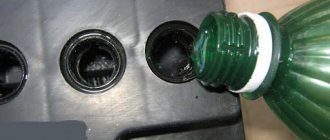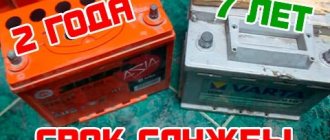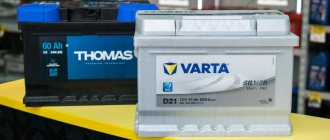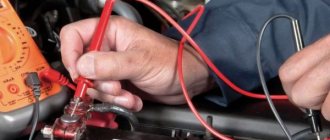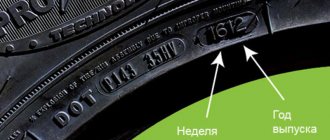Many motorists are familiar with the problem of rapid battery discharge even in the absence of a high load.
There are very severe cases - a battery charged 50% today becomes completely discharged tomorrow and this is discovered when trying to start the engine. A motorist charges the battery to 100%, but tomorrow it is half discharged again. How to solve this problem? Buying a new battery is not cheap, but replacement is not objectively required in every case; sometimes checking the density and topping up the electrolyte is enough.
Many car owners are concerned about the advisability of adding electrolyte to a battery if its density is insufficient. Perhaps it would be better to make a replacement? Let's consider different situations to find out how best to act in a given case.
Complete replacement of electrolyte in the battery
The electrolyte is a mixture of sulfuric acid and water in a certain proportion. The concentration of a solution is determined by the density measured by a hydrometer. The basic indicator, even hundredths, affects the ability of the electrolyte to work to store energy.
Signs of an unusable electrolyte:
- Measuring density on a charged battery with a hydrometer. The value should be 1.25 -1.27 g/cm3.
- A cloudy electrolyte is evidence that parasitic sulfation processes are taking place inside.
- The electrolyte froze, but the seal of the case was not broken.
- The solution is black or dark brown with a suspension of coal and scale.
Replacing the electrolyte in a battery will be effective when the cavities of the cans are examined, washed, and sulfate deposits are removed. If the plates are destroyed and the active substance has fallen off, the battery cannot be repaired.
At home, a complete replacement of the electrolyte in a car battery occurs in the following sequence:
- Prepare enamel or glass containers for draining the electrolyte, personal protective equipment, and a place to work, preferably outdoors.
- Remove the battery from the car, remove the plugs or drill holes in the maintenance-free battery, drain the liquid into a prepared container using a bulb or syringe.
- The battery is washed with distilled water several times until the sediment is removed. Lead sulfate may need to be removed if there is residue on the plates. You need to make sure that the active putty has not crumbled and that the coal grate is intact.
- Slowly, intermittently, pour the electrolyte of the required density into each jar 5-7 mm above the plates. Wait 2-3 hours for the bubbles to come out, measure the density of the electrolyte, bring it to normal
- After replacing the electrolyte, charge the battery with a low current of 0.1 A, avoiding boiling. After reaching half the capacity, charging is carried out cyclically.
- Seal the cans.
How long does it take to charge the battery? After replacing the electrolyte, you need to charge the battery carefully, as after a deep discharge. The operation of replacing the electrolyte with your own hands in a car battery is considered complete if it fully accepts current for a long time. Charging is carried out carefully; boiling in jars is unacceptable.
We invite you to watch a video on how to properly replace the electrolyte in a car battery.
This is interesting: Is it possible to use fog lights as daytime running lights?
What kind of fluid is in the battery?
Before talking about the liquid that is in the battery, let us clarify that this article is about serviceable batteries. If the battery has a different design and the manufacturer does not provide the ability to control the level and top up fluids in the battery, then this is not possible.
Of course, if necessary, you can convert a maintenance-free battery into a serviceable one. But in this case, you need to understand that you can cause irreparable harm to the battery, after which all that remains is to dispose of it.
You also need to understand that a special gel can be used as an electrolyte. These are so-called gel batteries. The manufacturer of such batteries also does not provide for adding fluid.
Thus, let us determine that in our case we are talking only about serviceable batteries. They use a solution of sulfuric acid and water as an electrolyte. This ratio is 3:7 (30% sulfuric acid to 70% distilled water).
You can learn more about the processes occurring in the battery, the composition of the electrolyte and methods of its preparation by reading the article “what acid is poured into the battery.”
When is adding electrolyte to the battery more appropriate than replacing the battery?
The electrolyte components of any battery are acid and distilled water. These liquids form a mixture in which water predominates, while acids are much less. For example, you need an electrolyte whose density should be 1.28 g/cu. cm. In this case, 0.36 liters of acid must be poured into 1 liter of distilled water. The proportion will be approximately 1:3.
For safety, it is necessary to pour acid into water, but in no case the other way around! Otherwise there is a high risk of a chemical reaction resulting in heat and splashing. Contact of battery acid with the skin will cause severe burns. The reason for this is the lower density of water compared to acid, as a result of which these liquids mix extremely slowly.
The volumetric proportion of water and acid is determined using a hydrometer. This device determines the density of a liquid. After reducing the density of the electrolyte to a certain value, it does not retain the charge well enough. If the density is slightly below the required 1.3 g/cc, electrolyte should be added.
The change in electrolyte density depends on the battery charge. For this reason, the exact density of the battery fluid is only possible when the battery is 100% charged. You can read how to properly charge the battery in a separate article.
%rtb-4%
How to add distilled water
To top up the water, distilled water is required. Raw tap water or boiled water is not suitable, because... contains impurities that negatively affect the course of chemical processes and can even worsen the condition of the battery, because impurities settle on the battery cells. Boiling does not remove hard impurities, salts and metals from water; boiling can only kill bacteria and microbes in the water.
The brand of distilled water you fill does not matter. The battery plugs are unscrewed and water is carefully added to the level marked on the monoblock. If the monoblock is not transparent, then add enough water to completely hide the electrodes, and the water supply on top is at least 1 cm.
After adding water, it is recommended to charge the battery on a charger. A fully charged battery will have a density of 1.26-1.28. If the density is significantly different, then something went wrong and you better contact a specialist.
How to determine the required quantity for a battery?
You can understand how much is needed to replenish the mixture with electrolyte (provided that this is what is needed) or distilled water (in a similar case) in the following ways.
Visually
The manufacturer applies special “risks” min – max to the battery case. It is by the marks on the battery that you can navigate how much is required (and what exactly) to add to the mixture. When filling, you must ensure that the required amount is added above the minimum mark, but below the maximum.
If there are no marks on the body, then you need to add so that the metal plates are covered by 1-1.5 cm.
Instrumentally
There are special measuring tubes with which you can measure the level of the electrolytic mixture.
If you don’t have a device, you can use any glass or plastic rod. A stick 20-25 cm long and 5-7 mm thick is suitable.
Having opened all the cans, you need to measure the level in each one individually. To do this, lower the tube all the way and lift it up. It will clearly show how much mixture is in the battery jar.
You need to add until the level reaches a height of 1.5-2.0 cm. If distilled water is added to the required level, the density of the electrolytic mixture will be restored to its original parameters of 1.27 g/cm3. This is necessary to ensure full operation of the battery.
Attention! Topping up maintenance-free batteries is not provided by the manufacturer! Access to the banks is strictly limited by the complete sealing of the housing.
The video provides detailed information on how to measure the electrolyte level in a battery:
How to recharge the battery?
Before you start deciding whether to add water or electrolyte to the battery, it is important to decide whether the mechanism needs to be refilled at all. For this purpose, you need to carefully inspect your existing unit. Mostly, the housing of all batteries is made of transparent plastic, which allows you to visually determine the amount of electrolytic solution inside. There are almost always marks on the battery case, by which you can determine whether the emulsion needs to be topped up or not.
If the housing is made of opaque material, you can check the emulsion level in the following way:
- Unscrew the battery cap. Thoroughly clean the front surface of the unit first so that when opening it, no dirt particles get into the system.
- Take a transparent tube with a diameter of no more than five millimeters and lower it all the way into the opening.
- Close the outer end of the tube tightly with your finger and pull the device out of the system without releasing your finger.
- The criteria are considered normal when the height of the liquid in the elongated tube is approximately one and a half centimeters. If the parameters do not match, it is necessary to top up or remove excess liquid.
If the need for topping up has been established, then you need to decide what needs to be added to the battery. A special device called a “hydrometer”, which can be used to measure the density of the solution in the battery, can help in this situation. Based on the test results, the cause of the mechanism malfunction is determined, and the dilemma of whether to add water or electrolyte to the battery is resolved. Using the device, measure the density of the battery fluid: normally it should be from 1.27 to 1.29 grams per cubic centimeter. If the density is significantly lower, then an electrolyte will need to be added. A density exceeding 1.29 units indicates that water must be added to the battery.
The procedure for adding water and electrolyte is carried out according to a similar scheme:
- If the case is transparent, add the required fluid to the level marked on the battery itself using a bulb or syringe. Otherwise, add liquid portionwise, systematically checking its level using a transparent tube according to the algorithm described above class=”aligncenter” width=”1000″ height=”563″[/img]
- After adding liquid, tighten the cap and shake the battery well so that the solution is thoroughly mixed in the system. Check the density again. If the result does not correspond to the norm, remove part of the emulsion using a syringe and add the required liquid again. Re-check the resulting solution.
- When the indicators have reached normal parameters, leave the unit to stand for several hours, you can put it on gentle charging during this time so that the liquid mixes as well as possible and acquires a uniform consistency. After the specified time has elapsed, carry out a control check of the density of the solution in the battery. Normal indicators indicate the correctness of the procedures performed and the possibility of further operation of the battery.
When performing the procedure for “resurrecting” the battery, remember that incorrect work performed can not only lead to a complete malfunction of the unit, but also lead to problems with car electronics. Check the odometer readings very carefully and you will succeed. If you need to fill the distillate, never fill it with regular tap water - it contains a lot of additives that will negatively affect the functioning and service life of the battery.
What does the battery consist of?
The battery in a car is responsible for starting the engine, the proper operation of all the car’s electrics, and also “smoothes out” voltage surges. Inside the housing, it consists of 6 series-connected elements consisting of positive and negative conductive plates. These elements are filled with electrolyte, interaction with which ensures the result of the work.
The liquid itself consists of distilled water and acid mixed in a certain proportion. The norms of proportions change depending on the required density of the mixture, and the norms of mixture density, in turn, depend on the temperature and climatic characteristics of the area where the car is used.
What is an electrolyte and its role in a battery?
To start the engines of modern cars, acid batteries are used, which are filled with a special solution that conducts electric current. It consists of sulfuric acid dissolved in pure distilled water. Ready-made electrolyte is offered by some automotive stores with a density of 1.29 g/cc. see Previously, ready-to-use batteries were offered, as well as dry-charged batteries that needed to be prepared for operation in a certain way.
To do this, you should adhere to the following algorithm:
- First, the battery needs to be filled;
- let the plates soak for an hour;
- recharge it with a current not exceeding 1/10 of the battery capacity;
- the voltage at the terminals during charging should be approximately 13.6-14.4 volts.
Electrolytic fluid plays an important role in the operation of a car battery.
Inside the case of a modern battery there are lead plates of different polarities. The positive grids are coated with lead dioxide, and the negative grids are simply lead in powder form. To increase strength and ductility, antimony was previously included in their composition. Calcium and silver are used to alloy the lattices of modern units. This significantly reduces water consumption during operation.
During the operation of the battery, chemical reactions occur when the atoms of the porous lead plates interact with a solution of sulfuric acid. When charging, the lead atoms are released from the electrons of the sulfuric acid. The electrolyte density increases. Battery discharge is accompanied by lead binding and a decrease in density.
Battery device
The degree of charge is determined by the density of the electrolyte. Depending on the ambient temperature, the norm is 1.24-1.27 g/cc.
Today we offer serviced, low-maintenance and maintenance-free batteries. Only the first two varieties have access to the electrolyte.
Preparatory work
Before servicing the battery, you should study the instructions, which fully describe how to properly add electrolyte to the battery, and it is also important to read the charging instructions .
In order to properly add electrolyte to the battery, it is important to prepare the workplace where this operation will take place.
Also, do not neglect safety precautions:
- The first thing you need to do is put on overalls, which includes a set of pants, a jacket, rubberized gloves and safety glasses.
- Place the battery on the workbench and clean it of various dirt using a rag. The main attention should be paid to the positive and negative contacts.
- Check the battery with a multimeter.
- Carefully open the covers using a Phillips screwdriver.
This is interesting: How many liters of oil are in a Peugeot 3008 engine
In what cases should electrolyte be added to the battery?
Electrolyte is added to the battery when the capacity decreases. At the same time, measurements of the contents of each jar with a hydrometer show a decrease in density. It is possible that sulfation has occurred in the battery; the bound acidic residue in PbSO4 does not participate in the reaction.
If the electrolyte extracted from the jars is transparent and light, it can be reused by adding a correction solution with a density of 1.4 g/cm3. After removing the sediment on the plates, the battery is filled with the same electrolyte, but it is of low concentration. Is it possible to bring the solution to the desired density by adding electrolyte? What composition should I take, and how much correction solution should I add to the battery?
According to the technology, you need to replace a portion of a weak composition with a strong one. You can add and remove the electrolyte solution from the jars using a bulb and a measuring cylinder. How to change solutions, in what proportion can be seen from the table.
In this case, only electrolyte should be used for correction. After the replacement operation, recharging is carried out for half an hour so that the liquids mix. Two hours after turning off the charger, the density is checked, if necessary, the adjustment is repeated.
We suggest you watch the video on how to add electrolyte to the battery.
How do the properties of electrolyte change in a vehicle battery?
Many professionals consider the question of what to put in the battery to be absolutely incorrect, since the device is classified as a non-repairable element. However, a good battery is far from a cheap pleasure, so the desire of car owners to extend its service life is understandable. To ensure that refilling the battery does not lead to its complete failure, you first need to understand the processes that occur during the operation of the battery during its systematic charging and discharging.
Initially, from the factory, the battery contains an emulsion, which consists of thirty-five percent sulfuric acid, while the remaining sixty-five percent of the volume is distillate - purified water, without impurities. During operation, the device heats up, an electrolysis reaction occurs, and part of the water evaporates under the influence of high temperature and collects as condensate on the inner surface of the unit. If the battery has a completely sealed design and there is no mechanical damage in the case, then when it cools, the steam turns into water and flows back down the walls of the device. If there is damage to the case as a result of operation of the device or due to poor manufacturing quality of the product, the water evaporates from the battery irretrievably. As a result of this process, the liquid in the battery becomes more concentrated, and the density of the acid increases. This is reflected in the voltage output criteria of the device and its performance.
Battery Maintenance
After a series of these manipulations, ensuring convenient maintenance, specialists carry out a complete diagnosis of the technical condition of the battery. Basically they consist of six points:
Before deciding what to add to the battery: electrolyte or water, you must fully charge it with a special device.- Next, measure the density in all jars using a hydrometer and record all the results in a notepad. When recording readings, it would be more convenient to put a number on each jar and indicate the value from the scale opposite it.
- If the density readings of a charged battery in some banks differ and are not within the recommended standard (1.25-1.29 g/cc), this means that the driver needs to make an adjustment. It is as follows: if the density reading is low, you need to calculate how much electrolyte to add to the battery and fill it, and if the density is high, add distilled water.
- The density of each can is at its limit, and for some reason the electrolyte level is falling lower and lower. The best solution for this problem is simply adding water.
- Sometimes it happens that the density in sections is lower than the nominal value (less than 1.21 g/cc). To find a solution, you need to take a small acid solution using a special enema and pour it into a measuring cup. Next, record the volume readings and pour the electrolyte into a glass mug. Using the technical table, pour the required amount of high-density sulfuric acid solution into a measuring glass and, using an enema, pour it into the jar from which the electrolyte was taken. In situations where there is a significant difference in the direction of decreasing density, it is best to add acid with a density of 1.40 g/cc. see. It is important to achieve the required level with distilled water.
- After the density has become the same in all banks, you need to connect the battery for a small recharge. This is done so that the recently poured solution is thoroughly mixed inside. After this, measure the density again, and if its level has changed, then repeat the operation.
Every car enthusiast needs to know that before switching to winter operation of the car, it is important to increase the density values in the battery, and lower it when switching to summer time.
And also every day before each departure you need to check not only the oil level in the engine, but also the cleanliness of the battery terminals and the reliability of the plugs on its body.
Distilled water or electrolyte
If you independently study the technical literature, you can easily understand that during operation of the battery, a certain part of the liquid evaporates from it, due to which the level of electrolyte above the plates decreases, and the density of the acid increases several times.
Therefore, we can conclude that an insufficient level of electrolyte in the battery during daily use has a significant impact on the condition of the plates and suddenly reduces the shelf life. Only with constant maintenance of the required acid level is the negative effect of increased density on the battery reduced.
Many experienced mechanics know when to add electrolyte to a battery, but most often they pour distilled water into it, because acid does not have the property of evaporating when boiling, so only oxygen and hydrogen come out of the battery.
It is important to remember that if there is little electrolyte in the battery due to its loss, for example, it spilled when the lids were open, then in this case you can safely pour it into the necks .
It also happens that when checking the density in all battery compartments, its reduced value is noticed. From this we can confidently conclude that partial sulfation of the battery has occurred. When the amount of electrolyte becomes less due to the crystallization of sulfur on the plates, then in this situation the battery simply needs urgent restoration.
We recommend: Characteristics of the Bosch s5 car battery
How to disassemble a maintenance-free battery to add electrolyte
In modern batteries, such as VARTA, under the decorative sticker you can see 6 plates, tightly recessed into the case. If you pry the circle with an awl, you can find a rubber stopper underneath it. Then it will be possible to take a sample of the electrolyte, measure the density, and adjust the composition. If there is no stopper, a hole is made in each jar with a thin awl, and water is released from a syringe in drops.
But if it is found that there are whitish streaks on the plates in the jars, this is sulfation. To clean the cavities and remove sediment below, you will need to open the lid by sawing.
Watch the video on how to add electrolyte to a maintenance-free battery.
Add electrolyte to the gel battery
A maintenance-free gel battery is the same as a lead-acid battery, but the electrolyte has been thickened and is in the form of a gel. Over the years, electrochemical parasitic reactions produce hydrogen escaping from the rubber vent valve. The gel becomes dehydrated and no longer adheres tightly to the plates. The battery capacity decreases.
Adding water to the battery cans is easy. You need to remove the sticker on the body, remove the valve caps and drop 1.2 ml of water into each jar. The water should be absorbed into the jelly-like mass. Need time. After half an hour, if the water is above the surface of the battery plates, remove it with a filter or syringe.
A little theory
The standard electrolyte density in batteries for central Russia is 1.25-1.30 g/cm. cube Ideally, if the indicator is 1.28 g/cc. see. If, for example, the battery freezes or boils, then the density of the electrolyte will change in one direction or the other, which will lead to the very rapid discharge of the battery. In this case, it is necessary to find the cause of the problem and eliminate it.
In your search, the main assistant will be a hydrometer - a special device with which the density of the electrolyte is determined.
A hydrometer that determines the density of the electrolyte
To use it, first of all, unscrew the round plug from each of the battery compartments, lower the device into the liquid and look at the resulting readings.
It is important to check each of the compartments!
It is also worth remembering that these manipulations are carried out on a device that is not working at the time of testing.
Another point - the liquid should cover the battery elements by 1–1.5 cm. If the fluid level is less, then topping it up is urgently necessary.
Closer to practice
If everything is clear with the definition of the problem, then the question arises: what is added to the battery - water or electrolyte? The result of measurements with a hydrometer will help with the answer: if the solution is too dense, then adding water will solve the problem. If the solution has too low a density, then you cannot do without an electrolyte.
Let's deal with water. Why is it so important to add distilled or, in extreme cases, melt water? The fact is that bottled water or tap water contains impurities that, when interacting with electricity, will at least produce sediment, and in worst cases will lead to complete deterioration of the battery. Therefore, the most purified water is necessary.
To add water, you will need an ordinary funnel, then charge the battery and re-check the density of the resulting mixture.
What to do with a lower electrolyte density?
So, the problem is this: the battery has stopped holding a charge. Is it worth changing it? Is it possible to add electrolyte to the battery at low density, or can the battery’s performance not be restored? The answer to this question depends on the age of the battery and the hydrometer readings when tested.
If the battery is old enough (for example, it is about 4-5 years old), then its inability to hold a charge is primarily due not even to the density of the electrolyte, but to a violation of the integrity of the plates in the battery banks. In this case, even restoring the previous density indicators will not solve the problem. However, if the battery is relatively new, the problem can be solved by adding electrolyte. The only question is whether it is necessary to fill in the electrolyte?
The average electrolyte density in a “working” battery is approximately 1.25-1.30 g/cm³. Moreover, this value should be approximately the same for each battery bank with a deviation of no more than 0.01-0.03. If the density of the electrolyte is less than 1.25, but more than 1.20, most likely adding electrolyte will help solve the problem.
We also watch a video on how to properly increase the electrolyte density in a battery:
